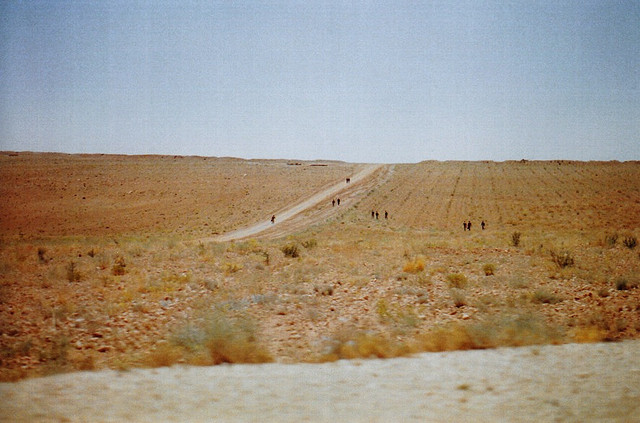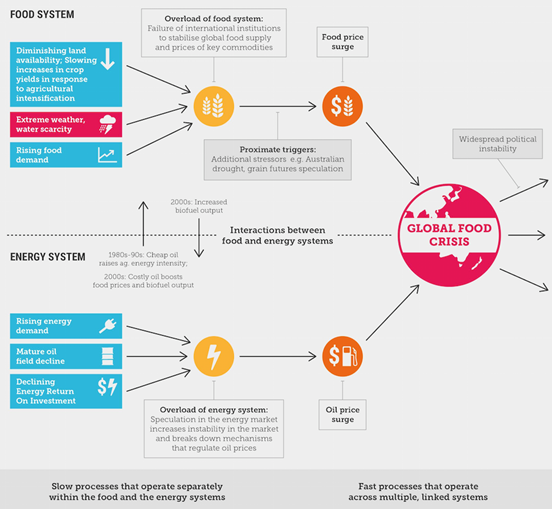Conflict and instability in the Middle East have dominated the news for quite a few years now, with the Arab Spring and the unfolding human tragedy in Syria ranking as two of the most significant events in the region. The recent emergence of ISIS and associated terrorist activities beyond the region are perhaps even more dramatic consequences. The geo-political, social and cultural factors that are fuelling the instability and conflict in the region are complex, well-known and difficult to deal with.
Climate change can exacerbate a wide range of existing, interacting, non-climate threats to security; it may contribute to a conflict, rather than being the sole cause. In this way, climate change is often viewed as a ‘threat multiplier’. The role of climate change as a threat multiplier often works through its impacts on the availability of food and water. Communities, societies, countries and regions experiencing shortages of food and water are more vulnerable to tension, conflict and migration.
The 2008 food and energy crisis is an example of how climate change can affect food availability and demand, and thus contribute to conflict and migration. The crisis caused the number of undernourished people around the world to increase from 848 million to 923 million. In the three years leading up to the crisis, food prices increased by 83% while global grain stocks were at their lowest level since 1982. Food riots erupted across Africa and the Middle East in 2008 as basic food prices soared. The cost of wheat increased by 127%, rice by 170% and the cost of maize by 300%.
Several non-climate related, long-term trends contributed to the 2008 crisis. First, steadily diminishing availability of new, high-quality agricultural land; second, slowing crop yield increases in response to agricultural intensification in many parts of the world; and third, rising global demand for food.
In addition to those stresses, changes in the climate played a significant role, especially in the Middle East. The Mediterranean region is currently experiencing an ongoing 50-year drying trend, likely linked to climate change, which puts significant stress on local and regional food production. Embedded in that long-term trend, from 2007 to 2010, Syria experienced its worst drought on record. Analyses by climate scientists suggest that climate change made a drought of this severity two or three times more likely than it otherwise would have been.
The 2008 food-energy crisis. (Source: Homer-Dixon et al 2015.)
That combination of stresses overloaded the global food system’s coping capacity, with particularly serious consequences for the Middle East. But even more stresses were to confound and deepen the crisis.
In addition to these direct stresses on the food system, rising oil prices in the 2000s drove up food prices through the increasing cost of food production, processing and distribution. But rising oil prices also encouraged some farmers to switch production from grains-for-food to grains-for-biofuels as a substitute for fossil-based transport fuels. That reduced food production and put even more pressure on the global food system.
This represents a major new link between food and energy. Because cropland can now be used for either feedstock for biofuels or for food production, the global food and energy systems have become even more closely interconnected.
Climate change exacerbated the 2008 food crisis even further. As the rising oil prices, diminishing global food stocks, and regional droughts around the Mediterranean really began to bite, an injection of grain into the global system was badly needed to stabilise prices. However, at that point, the global food system took another hit.
In the 2008–09 period, Australia was suffering the peak of the Millennium Drought, significantly dropping wheat production in both the southwest and southeast grain growing areas. This meant that Australia could export less grain into the global market than it normally does, further tightening global supplies and driving up prices.
So what about the future? An independent expert taskforce from the UK and USA has found that climate change is increasing the risk that a significant ‘weather-related shock’ will hit global food production, destabilising global grain markets and affecting the well-being of individuals and societies in vulnerable countries. The analysis suggests that the risk of a 1-in-100 year production shock event from extreme weather could increase to a 1-in-30 year risk or more in the next few decades.
There’s a clear bottom line here.
Ultimately, climate change represents a potentially catastrophic shift in the planetary life support system that has supported human existence and development since modern humans evolved some 200,000 to 250,000 years ago. Climate change is far more than just an environmental issue: it fundamentally changes our relationship with food and water, both of which are essential to our well-being and for the viability of nearly all other forms of life.
We have collectively built and optimised all of human civilisation for the relatively stable climate that has existed for thousands of years, starting at the end of the last ice age. That climate is now changing rapidly. We must adapt to the inevitable changes that are already occurring while working hard to minimise the long-term change, some of which could be massive, abrupt and disruptive to a planet currently carrying over 7.3 billion people, all of whom want, expect, and have a right to a decent and safe standard of living.
We will need to meet the challenge of climate change in a context of existing regional, political and ethnic tensions, an ever-increasingly globalised society, and one that’s becoming more interconnected by the month. Climate change is one of the largest long-term, global challenges humans have faced in the history of civilisation. The implications for the security sector and defence forces are formidable.



